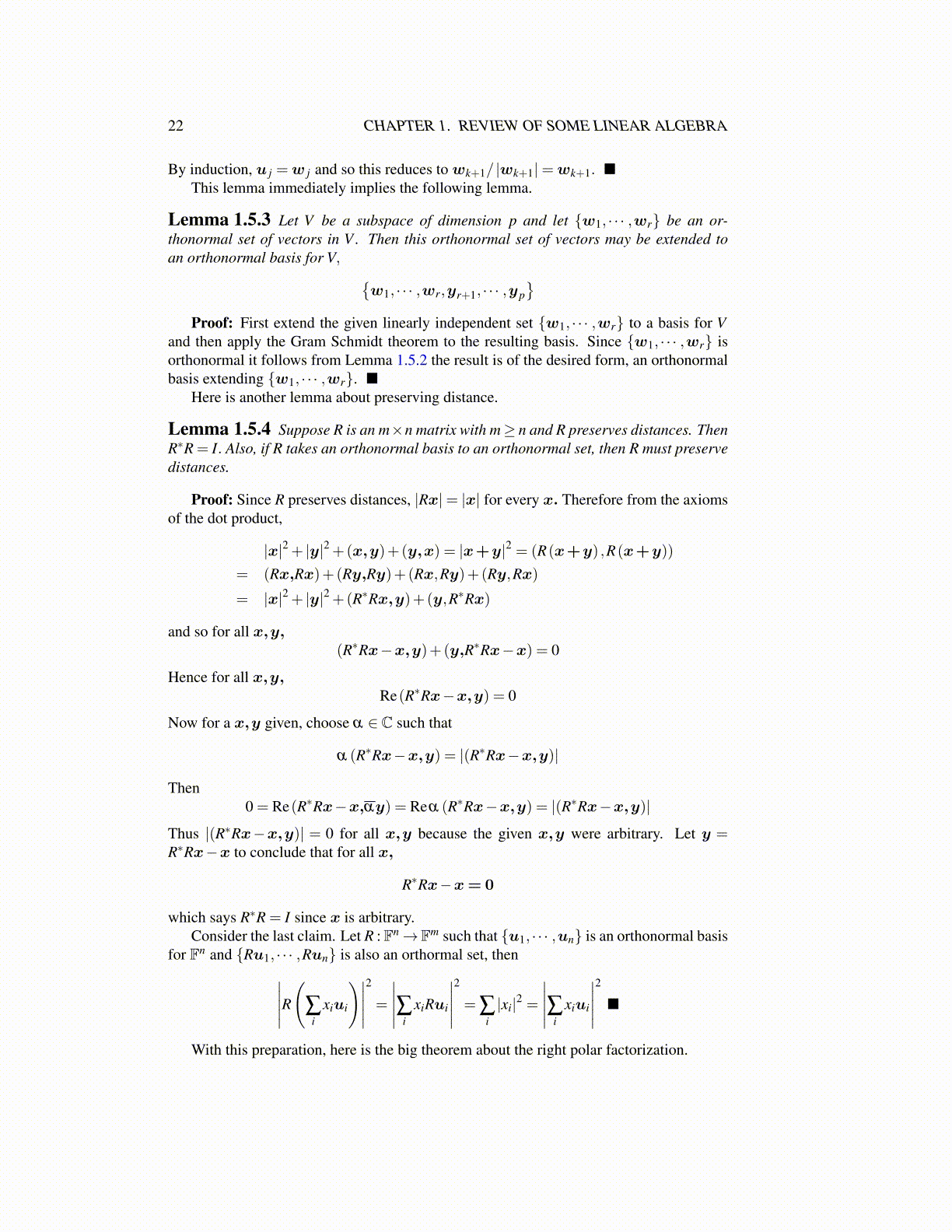
22 CHAPTER 1. REVIEW OF SOME LINEAR ALGEBRA
By induction, u j =w j and so this reduces to wk+1/ |wk+1|=wk+1. ■This lemma immediately implies the following lemma.
Lemma 1.5.3 Let V be a subspace of dimension p and let {w1, · · · ,wr} be an or-thonormal set of vectors in V . Then this orthonormal set of vectors may be extended toan orthonormal basis for V, {
w1, · · · ,wr,yr+1, · · · ,yp}
Proof: First extend the given linearly independent set {w1, · · · ,wr} to a basis for Vand then apply the Gram Schmidt theorem to the resulting basis. Since {w1, · · · ,wr} isorthonormal it follows from Lemma 1.5.2 the result is of the desired form, an orthonormalbasis extending {w1, · · · ,wr}. ■
Here is another lemma about preserving distance.
Lemma 1.5.4 Suppose R is an m×n matrix with m≥ n and R preserves distances. ThenR∗R = I. Also, if R takes an orthonormal basis to an orthonormal set, then R must preservedistances.
Proof: Since R preserves distances, |Rx|= |x| for every x. Therefore from the axiomsof the dot product,
|x|2 + |y|2 +(x,y)+(y,x) = |x+y|2 = (R(x+y) ,R(x+y))
= (Rx,Rx)+(Ry,Ry)+(Rx,Ry)+(Ry,Rx)
= |x|2 + |y|2 +(R∗Rx,y)+(y,R∗Rx)
and so for all x,y,(R∗Rx−x,y)+(y,R∗Rx−x) = 0
Hence for all x,y,Re(R∗Rx−x,y) = 0
Now for a x,y given, choose α ∈ C such that
α (R∗Rx−x,y) = |(R∗Rx−x,y)|
Then0 = Re(R∗Rx−x,αy) = Reα (R∗Rx−x,y) = |(R∗Rx−x,y)|
Thus |(R∗Rx−x,y)| = 0 for all x,y because the given x,y were arbitrary. Let y =R∗Rx−x to conclude that for all x,
R∗Rx−x= 0
which says R∗R = I since x is arbitrary.Consider the last claim. Let R : Fn→ Fm such that {u1, · · · ,un} is an orthonormal basis
for Fn and {Ru1, · · · ,Run} is also an orthormal set, then∣∣∣∣∣R(
∑i
xiui
)∣∣∣∣∣2
=
∣∣∣∣∣∑ixiRui
∣∣∣∣∣2
= ∑i|xi|2 =
∣∣∣∣∣∑ixiui
∣∣∣∣∣2
■
With this preparation, here is the big theorem about the right polar factorization.